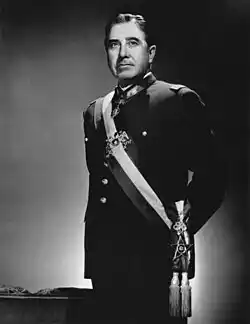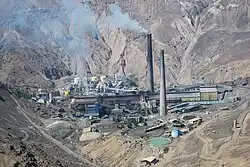
The military dictatorship of Chile refers to the dictatorship of Augusto Pinochet in Chile between 1973 and 1990. The unexpected rise to power of this relatively unimpressive military bureaucrat came about owing to the drift of Chile’s politics in the early 1970s under the radical socialist president, Salvador Allende. Having seized power Pinochet engaged in an unprecedented program of economic reform influenced by the Chicago school of economic theory led by Milton Friedman. This resulted in considerable economic growth in the 1970s, but a monetary crisis and stagnation followed in the 1980s. During the long dictatorship thousands of Chileans were killed by the government or simply went missing, never to be seen again. Many people fled the country to avoid political persecution. Eventually, Pinochet agreed to step down as president in 1990. He was later arrested for human rights’ violations in London in 1998 and spent most of the remainder of his life fighting legal battles pursuant from his time in office.[1]
Research your ancestors on MyHeritage
Military dictatorship of Chile chronology of eventsMilitary dictatorship of Chile chronology of events

In the middle of the twentieth century, Chile was one of the most affluent countries in South America, generally enjoying a GPD per capita which only Uruguay could rival. This was entirely owing to Chile’s exports of copper, the country being the largest producer of the metal in the world for much of modern history. This created greater levels of wealth in Chile comparative to its neighbors in South America, but it also left the country overly reliant on world copper prices staying high. Thus, when copper prices declined dramatically in the early 1970s it left the Chilean economy badly exposed at a time when the socialist president, Salvador Allende, was already being deliberately undermined internationally by the administration of President Richard Nixon in Washington D.C., whose administration views Allende as a potential new ally of the Soviet Union in Latin American within the context of the wider Cold War.[2]
Nixon and his Secretary of State, Henry Kissinger, viewed Allende as a potentially dangerous figure in South America. Therefore, when they became aware that a military coup was being planned in Chile in 1973 in response to the economic and political turmoil that collapsing copper prices were creating, they decided not to intervene in any way. The coup of 11 September 1973 brought Augusto Pinochet to power. He was an unlikely figure to become dictator of the country. Pinochet was in his late fifties and had spent decades rising steadily, though without accomplishing much of note, through the ranks of the army, eventually becoming chief of the military staff. He was in effect a military bureaucrat. This was the man who became dictator in the autumn of 1973.[3]
Pinochet would serve as President of Chile from 1974 to 1990. His time as dictator has aroused considerable debate. This is primarily owing to the economic policies he pursued. In the mid-1970s Chile became a laboratory to test the economic theories developed by Milton Friedman and other economists based out of Chicago. They favored the idea of ‘shocking’ a troubled economy back to life by engaging in a radical program of nationalization and encouragement of private enterprise, while also reducing the size of the welfare state. Today we would call this neo-liberalism.[4] Initially it was enormously successful. Chile returned to growth in 1976 and between 1977 and 1980 the economy grew by an average of 8% per year. But this was followed by an 11% contraction in 1982 and much more modest growth throughout the 1980s, while the 1990s brought fresh economic problems. Nevertheless, many of the policies employed by the military dictatorship in Chile were later adopted by Ronald Reagan and Margaret Thatcher in the US and UK in the 1980s.[5]
While Pinochet’s economic policies are a point of contention, there is no real denying the human rights’ violations of the military dictatorship. In order to crush the socialist movement in the country, tens of thousands of people were detained, tortured and imprisoned. Thousands were killed, while many more simply disappeared and were never heard from again. Pinochet was also responsible for the notorious Operation Condor whereby South American countries facilitated each other’s repressive policies and silencing of opposition views.[6]
Eventually, in 1990, by which time he was in his mid-seventies, Pinochet agreed to step down from the position of President as unrest grew that the economic policies of the 1970s had only produced temporary gains while creating long term systemic problems. He remained though as chief of the armed forces, albeit in a largely ceremonial capacity. Chile began to reform itself into a republic once again. In 1998, while visiting London, Pinochet was arrested and charged with breaches of international law. He successfully avoided major punishment on the grounds of ill health, yet when he died in 2006 there were hundreds of different charges pending against him ranging from corruption to murder.[7]
Extent of migration during the military dictatorshipExtent of migration during the military dictatorship
The seventeen years of the military dictator were ones of extensive emigration from Chile. This took two forms. Firstly, an estimated 200,000 socialists, leftists, academics and other opponents of the regime fled from the country in order to avoid political persecution. On top of this, the monetary and economic crisis which occurred in the early 1980s and peaked in 1982 led to plummeting living standards and high unemployment. Owing to this, several hundred thousand Chileans left the country in search of better economic opportunities overseas or elsewhere in South America. This essentially created the Chilean diaspora in a country which had typically been a source of inward rather than outward migration.[8]
Demographic impact of the military dictatorshipDemographic impact of the military dictatorship
The demographic impact of this was widely dispersed. Many of those who were fleeing from Chile in the 1970s did not feel that the United States would be a welcoming host to socialist refugees, while neighboring Argentina became increasingly unwelcoming when a military dictatorship was established there in 1976. In this environment, thousands of Chileans ended up heading to a wide-range of different countries. Several thousand settled in the UK. A good many migrated to East Germany where they were welcomed by the communist regime. Some 8,000 Chileans arrived to Belgium, while the influx into Sweden ensured that there are over 50,000 Swedish people with Chilean heritage today, such was the level of migration there in the 1970s and 1980s.
Today the Chilean diaspora is approximately one million strong. A huge proportion of this is owing to people who left the country between 1973 and 1990, whether fleeing political persecution or the economic crisis of the early 1980s. The main centers of this diaspora are the United States, Argentina, Spain, Sweden, Canada, Australia, France, Brazil, Norway and Germany.[9] Another unfortunate element of this, one which is much more difficult to assess the scale of, though which recent developments in DNA tests have revolutionized, concerns the theft of babies by the Pinochet regime. In the 1970s and 1980s thousands of mothers in Chile were separated from their children, who were then sent abroad for adoption. Many are only today locating their birth families 40 to 50 years later.[10]
See alsoSee also
Explore more about the military dictatorship of ChileExplore more about the military dictatorship of Chile
- Chile, Baptisms, 1585-1932 records collection on MyHeritage
- Chile, Marriages, 1579-1930 records collection on MyHeritage
- Chile, Civil Registration records collection on MyHeritage
- Chile, Santiago Burials records collection on MyHeritage
- Chile, Electoral Rolls, 2013 records collection on MyHeritage
- Research Latin America Genealogical Resources on the Internet at Legacy Family Tree Webinars
- Spanish & Latin American Records on MyHeritage at Legacy Family Tree Webinars
- Texas Firefighter Reunited with the Chilean Family He Was Stolen From as a Baby at the MyHeritage blog
- Chilean Adoptee Stolen as a Baby Reunites with His Sister at the MyHeritage blog
- Chilean-American Adoptee Reunites with His Family 42 Years After He Was Stolen From Them at the MyHeritage blog
References
- ↑ Chile under Pinochet - a chronology. The Guardian
- ↑ C. J. Tesar and Sheila C. Tesar, ‘Recent Chilean Copper Policy’, in Geography, Vol. 58, No. 1 (1973), pp. 9–12.
- ↑ The Allende Years and the Pinochet Coup, 1969–1973. Office of the Historian. Department of State
- ↑ Paul E. Sigmund, ‘The Rise and Fall of the Chicago Boys in Chile’, in SAIS Review (1956–1989), Vol. 3, No. 2: Latin America in Turmoil (Summer – Fall, 1983), pp. 41–58.
- ↑ 3 Liberalization, Crisis, Intervention: The Chilean Financial System, 1975–85. IMF eLibrary
- ↑ John Dinges, The Condor Years: How Pinochet and his Allies Brought Terrorism to Three Continents (New York, 2005).
- ↑ General Pinochet arrest: 20 years on, here’s how it changed global justice. The Conversation
- ↑ Chile: Moving Towards a Migration Policy. Migration Policy Institute
- ↑ ‘Chilean diaspora’, in Melvin Ember, Carol R. Ember and Ian Skoggard (eds), Encyclopedia of Diasporas: Immigrant and Refugee Cultures Around the World (New York, 2005), pp. 57–65.
- ↑ Chilean-American Adoptee Reunites with His Family 42 Years After He Was Stolen From Them. MyHeritage blog

